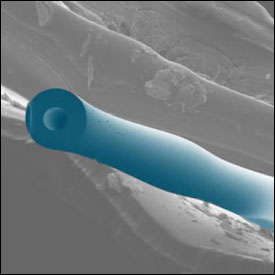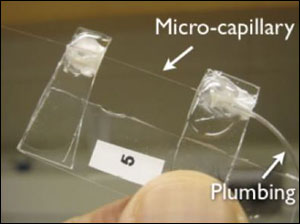URBANA, Ill., June 10, 2013 — Whispering galleries — circular spaces beneath a dome that capture and amplify sound as quiet as a whisper — have inspired numerous scientific discoveries over the past several years. Now the phenomenon, discovered more than a century ago, has been applied to the development of an optomechanical sensor that will help unlock vibrational secrets of chemical and biological samples at the nanoscale. The device is the first-ever bridge between optomechanics and microfluidics, its developers say.
“Optomechanics is an area of research in which extremely minute forces exerted by light (for example: radiation pressure, gradient force, electrostriction) are used to generate and control high-frequency mechanical vibrations of microscale and nanoscale devices,” said Gaurav Bahl, an assistant professor of mechanical science and engineering at the University of Illinois at Urbana-Champaign.
In glass microcavities that function as optical whispering galleries, according to Bahl, these minuscule optical forces can be enhanced by many orders of magnitude, which enables “conversations” between photons and phonons (vibrations). Such devices are of interest to condensed matter physics because the strong phonon-photon coupling enables experiments targeting quantum information storage, quantum-mechanical ground state and ultrasensitive force measurements past the standard quantum limit.

A false-color scanning electron micrograph of the microfluidic optomechanical resonator developed at the University of Illinois at Urbana-Champaign. By confining various liquids inside the device, the first-ever bridge between optomechanics and microfluidics has been built. It could yield optomechanical biosensors with the capacity to measure various optical and mechanical properties of a single cell or the optical control of fluid flow. Images courtesy of Gaurav Bahl, University of Illinois.
The researchers developed a hollow microfluidic optomechanical (µFOM) resonator made of fused silica gas, through which fluids and gases could flow, using a unique optomechanical interaction called Brillouin optomechanics. The device achieved the optical excitation of mechanical whispering-gallery modes at frequencies spanning from 2 to 11,000 MHz.
“These mechanical vibrations can, in turn, 'talk' to liquids within the hollow device and provide optical readout of the mechanical properties,” Bahl said.
Confining various liquids inside the resonator enabled the first-ever bridge between optomechanics and microfluidics.

A microfluidic optomechanical capillary resonator with fluid control tubing.
“We found that the optomechanical interaction in the µFOM device is dependent on the fluid contained within,” Bahl said. “These results are a step towards novel experiments probing optomechanics on nonsolid phases of matter. In particular, the high-frequency, high-quality-factor mechanical vibrations demonstrated in this work may enable strongly localized, high-sensitivity optomechanical interaction with chemical and biological samples."
Potential uses for this technology include optomechanical biosensors that can measure various optical and mechanical properties of a single cell, ultrahigh-frequency analysis of fluids, and the optical control of fluid flow.
The research appeared in
Nature Communications (
doi:10.1038/ncomms2994).
For more information, visit:
www.illinois.edu